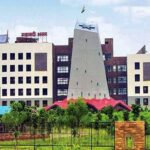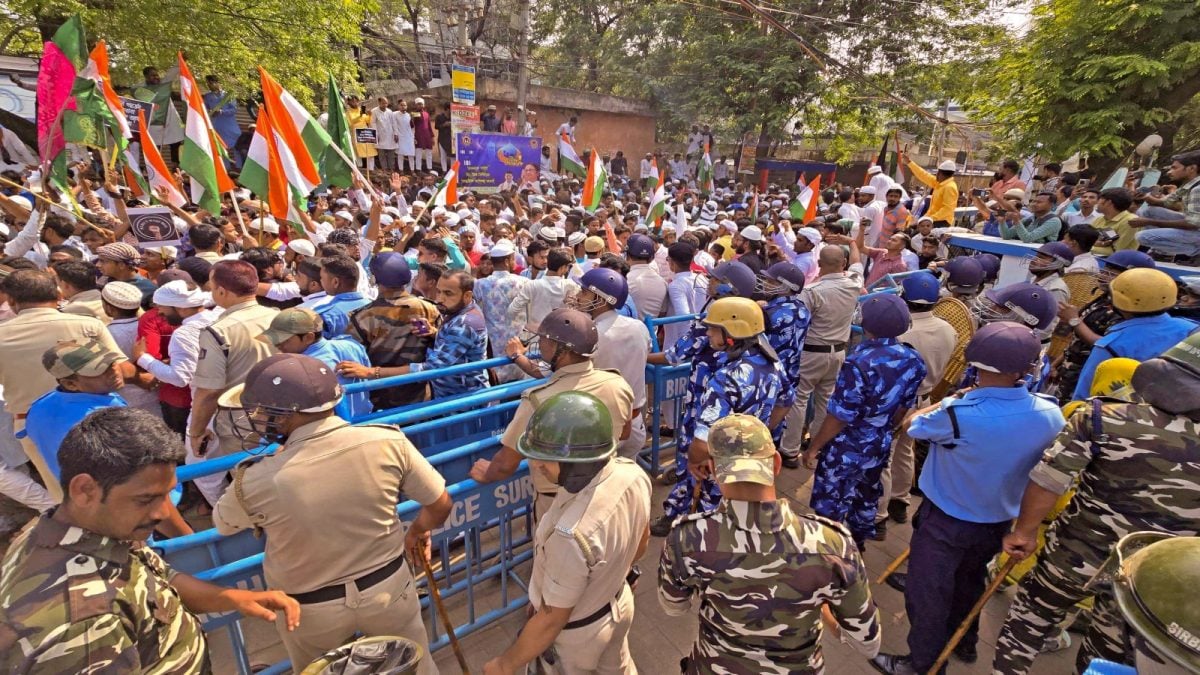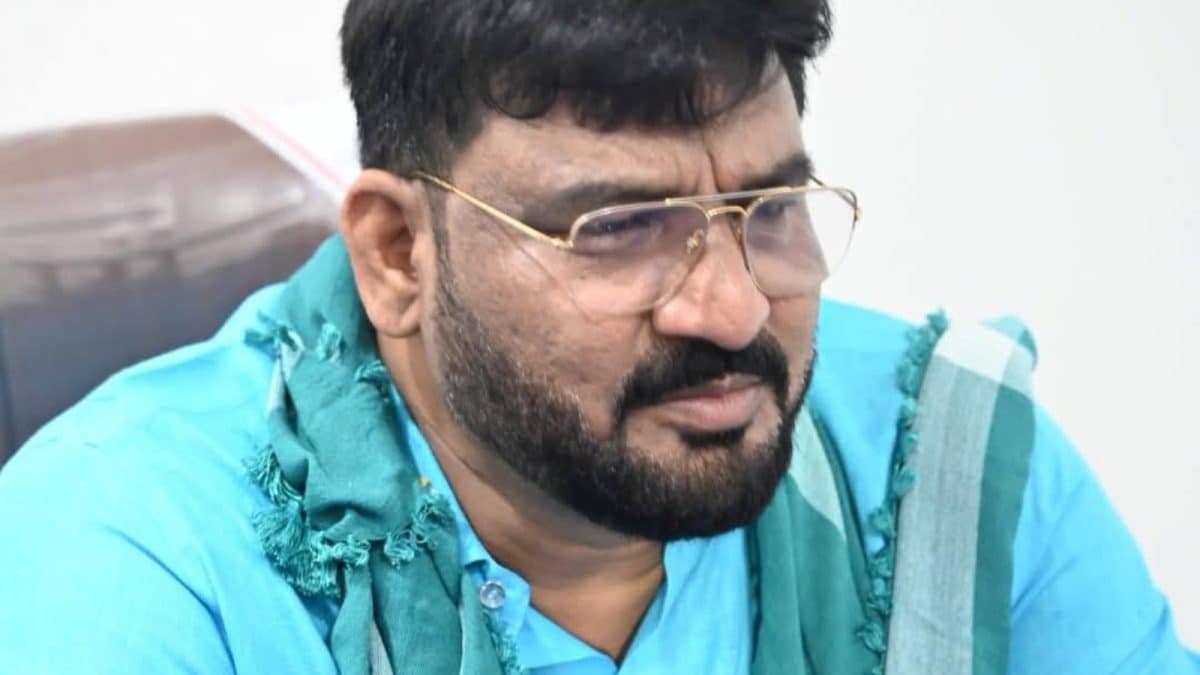Last Updated:
The violence, which started on Tuesday, almost a week after the passing of the Waqf Amendment Act in both Houses of Parliament, took an ugly turn on 11 April following Friday Namaz in areas such as Jangipur and Suti

Birbhum: Security personnel deployed outside District Magistrate office amid protest by members of the Muslim community against the Waqf (Amendment) Bill 2025, in Birbhum district of West Bengal, Friday, April 11, 2025. (PTI Photo)
In what the law enforcement authorities of West Bengal describe as a ‘pre-planned’ and ‘coordinated’ plot, sections of the Muslim population in the state’s border districts — Murshidabad, Malda, and parts of South 24 Parganas — unleashed a wave of unabated violence that rocked the state and reignited old political tensions.
Addressing the media on Saturday, West Bengal DGP Rajeev Kumar issued a stern warning against those inciting violence and spreading misinformation. In an emotional appeal, Kumar urged the public to refrain from circulating rumours, stressing that lives and property were at stake.
“The situation was brought under control last evening, and highways were reopened. We have our forces in place, and we are committed to using minimum force. However, fresh trouble began when an unruly mob assembled and attacked the police. They almost overpowered us,” he said.
Despite deploying all standard riot control measures — including the use of tear gas and baton charges — the situation escalated, prompting the police to open fire to protect people.
“Four rounds were fired as a last resort. Two individuals sustained injuries and are currently hospitalised but out of danger,” Kumar confirmed. He further added that reinforcements have been sent and a team of senior police officers, including officers of ADG and IG rank, are camping in the area.
Meanwhile, on Saturday morning, reports of another incident of firing spread. Jawed Shamim, ADG (Law and Order), said that the incident is still being verified but confirmed that the firing was not carried out by the police. BSF jawans deployed at the border were also called in by the government for area domination. The firing may have been carried out by them to disperse the mob. One person has reportedly sustained an injury and is also in the hospital but out of danger.
These districts, which share a sensitive and largely porous border with Bangladesh, witnessed a series of incidents of vandalism followed by unrest unfolding with striking precision, with Murshidabad’s Jangipur emerging as the epicentre of the chaos.
The violence, which started on Tuesday, almost a week after the passing of the Waqf Amendment Act in both Houses of Parliament, took an ugly turn on 11 April following Friday Namaz in areas such as Jangipur and Suti. The tension quickly spread to nearby locations like Samserganj and parts of Malda.
MURSHIDABAD: BENGAL’S COMMUNAL TINDERBOX
Significantly, all these locations — Jangipur, Raghunathganj, Dhuliyan, Samserganj, and Farakka — in Murshidabad district, which witnessed a series of unprecedented violent incidents, share a border with Bangladesh on one side and partly with Jharkhand on the other. Parts of these areas are also close to the borders of Birbhum and Malda districts. The topography is crucial to understanding the complex and volatile nature of the mob violence pattern here.
These areas often witness an influx of Bangladeshi groups crossing the border and settling illegally, as well as mercenaries and outsiders from other states, including Jharkhand, who enter Bengal, wreak havoc, and then leave.
The complex topography has led to a volatile and ever-changing demography in this region. Murshidabad and Malda districts have traditionally been Muslim-majority areas owing to the history of Nawabs ruling this region during the pre-colonial era for decades. However, the porous border and alleged political patronage have paved the way for almost ‘unrestricted’ illegal migration of Bangladeshis into the region. The appeasement policies of political parties have further emboldened them.
The Jangipur Parliamentary constituency, from where former President Pranab Mukherjee used to contest and win elections, has been held by the Trinamool Congress since the 2019 elections. Congress lost the seat to Trinamool and has failed to regain it in all elections held since 2019. The constituency, which has around 80 per cent rural population and approximately 65 to 68 per cent Muslims (according to the 2011 Census), has been on edge due to various communal incidents and violent protests.
In the 2024 general election, Trinamool’s Khalilur Rahman was re-elected from the Jangipur Parliamentary constituency, while Trinamool also won all seven assembly constituencies — Suti, Jangipur, Raghunathganj, Lalgola, Khargram, Nabagram, and Sagardighi — in the 2021 assembly elections. The Jangipur Lok Sabha seat comprises all these seven assembly segments. Last year, however, Jangipur saw an exception as the BJP took the lead in its Jangipur assembly segment during the Lok Sabha elections, which became a bone of contention in the area for both parties — the BJP and Trinamool — leading to further communal polarisation. Hindu voters have always been a minority in the Jangipur Parliamentary constituency.
Murshidabad, which used to be Bengal’s centre for trade and commerce during the Mughal era and even later under British rule, with Jangipur (then known as Jungypore) being the hub of the district’s silk trade and commercial residencies, has now been reduced to a place infamous for illegal migration and communal flare-ups.
RESEMBLANCE WITH CAA-NRC VIOLENCE
The violence that stunned the state administration and the public bore an uncanny resemblance to the turbulence witnessed across the state in the wake of the controversial NRC-CAA rollout, both in scale and symbolism. Interestingly, no other state, even those with Muslim-majority areas, witnessed such widespread violence following the passage of the Waqf Amendment Act. Chief Minister Mamata Banerjee issued a statement immediately after the Act was passed in Parliament, expressing her disagreement with it. A week later, Siddikullah Choudhury, a minister in her cabinet, delivered a speech — described by many as a ‘provocation’ — during a protest rally in Kolkata, saying Muslims would not accept such an Act against their religion. The protest rally took place early this week.
What began as sporadic outbursts quickly escalated into full-blown rioting in Murshidabad from Tuesday onwards and took an ugly turn.
Scores of vehicles, including police jeeps and administrative transport, were torched or heavily damaged. Critical infrastructure was not spared either — traffic outposts were reduced to rubble, and key government facilities, such as the office of the Block Development Officer (BDO), were targeted in a deliberate effort to cripple civic administration. Even the residence of a local Member of the Legislative Assembly (MLA) came under direct attack, raising the stakes and hinting at a deeper, more calculated political motive, according to sources in the administration.
As during the protest movements around the NRC-CAA implementation in the same areas, including Murshidabad and Howrah, public transport bore the brunt of the fury. Stones were pelted at vehicles on the national highway, blocking the roads, and several trains stationed at different junctions in Murshidabad were attacked. Protesters not only vandalised railway property but also blocked major rail lines, bringing regional connectivity to a halt. The Indian Railways, in a prompt response, diverted multiple trains to avert further damage and prevent passengers from being caught in the crossfire.
ISF’s INVOLVEMENT
While fingers were initially pointed at the ruling Trinamool Congress (TMC), given its alleged track record of ‘Muslim appeasement’, the emerging evidence tells a more complex story.
A police intelligence report, accessed by News18, has thrown fresh light on the orchestrators of the violence. According to the report, the Indian Secular Front (ISF) — a relatively new political outfit formed in 2019 out of growing disenchantment within segments of the Muslim community — played a pivotal role in both planning and executing the violent disturbances.
The ISF, formed by influential cleric Abbas Siddiqui, associated with the Furfura Sharif shrine, has carved out a unique political space for itself, often positioning itself as the voice of marginalised Muslims and Dalits dissatisfied with the TMC’s perceived failure to safeguard their interests. What began as a socially rooted movement has gradually evolved into a potent political force, capable of mobilising large crowds and influencing public sentiment across Bengal’s border belt.
Sources within the police claim that the ISF leadership exploited long-standing socio-political grievances and used them as a rallying cry to incite violence. The timing, nature, and spread of the unrest — along with the selection of targets such as government offices, transport infrastructure, and political residences — suggest a well-structured operation rather than a spontaneous uprising, added the sources.
Police have arrested almost 128 persons from ground zero, and their identities are now being ascertained for further investigation. However, the involvement of external elements, including illegal Bangladeshis or mercenaries from other states, has not been ruled out.
The series of incidents raises serious questions about the fragile balance along Bengal’s border districts, the influence of fringe political outfits, and the challenges of managing communal sentiment in a politically charged environment. With assembly elections looming and the political landscape becoming increasingly fragmented, such violence — if unchecked — could set a dangerous precedent.
As investigations unfold, and as the state tries to regain control over the affected regions, the larger question remains whether these communal flare-ups will continue to grow over the deeper and more volatile fault lines emerging in Bengal’s border politics.










